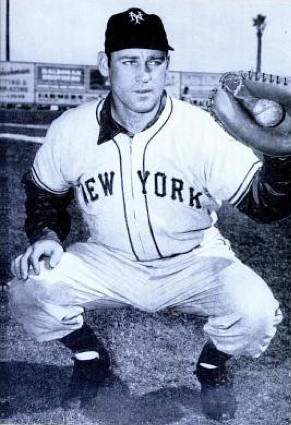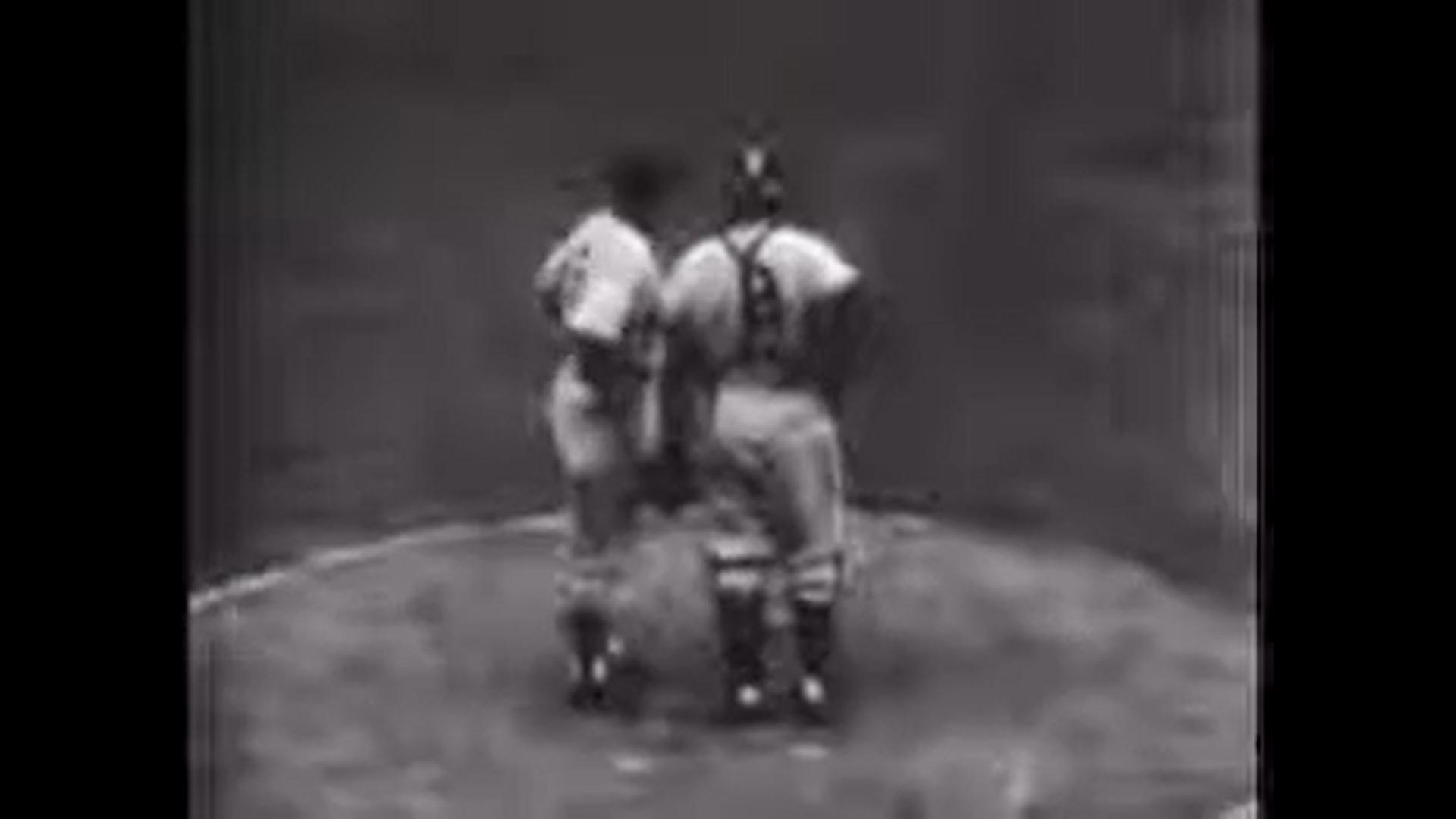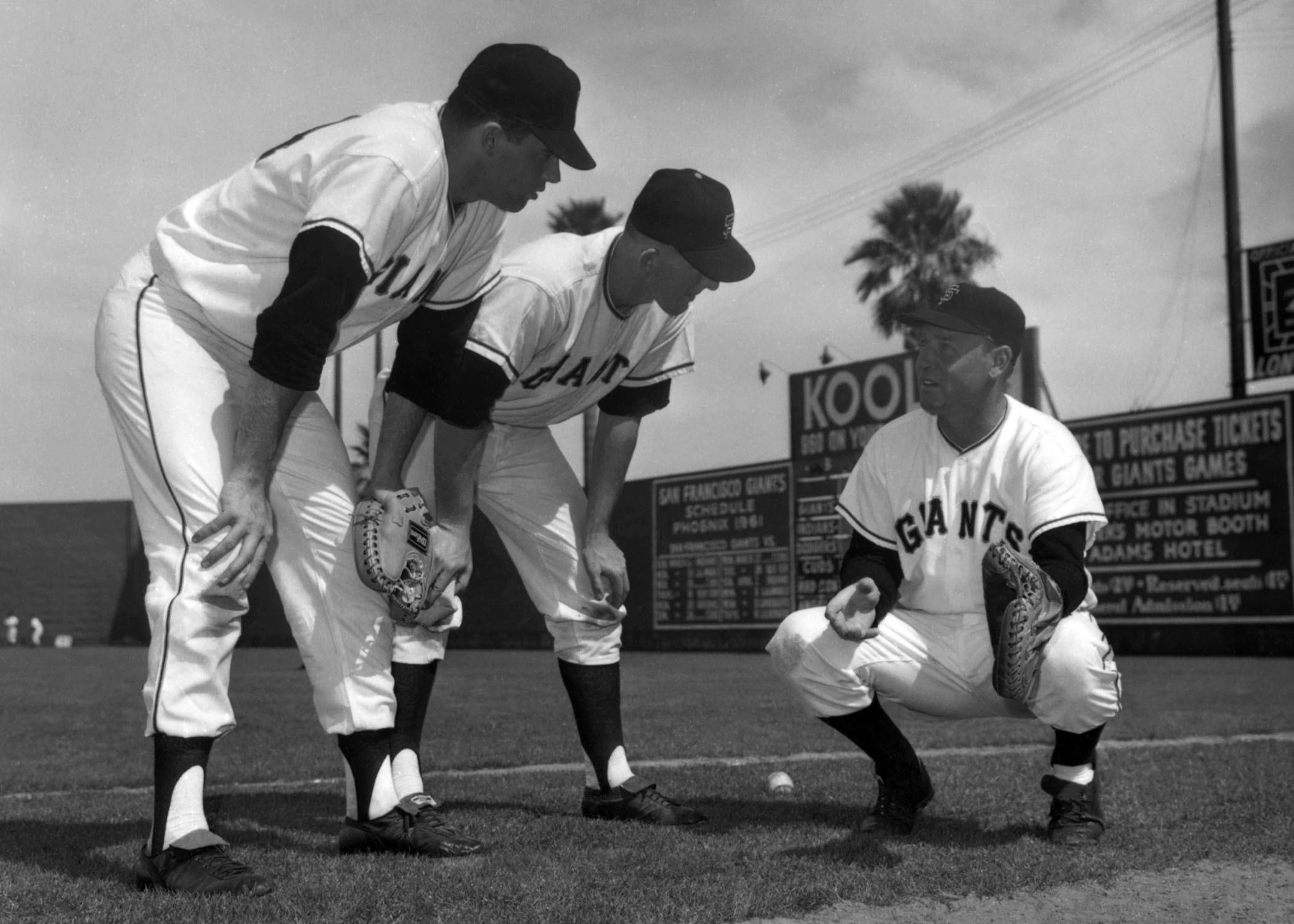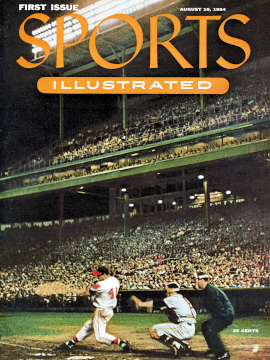
By Micah Friez
Published 4:32 p.m. on Oct. 2, 2024
When the New York Giants got the final out of the 1954 World Series and converged to celebrate, their catcher found himself in the middle of the pile.
It was uncharted territory for a Bemidji State Beaver.
But that was the honor earned by Wes Westrum, a Bemidji State Teachers College product and suddenly the first Beaver to ever win the World Series. Seventy years ago today, on Oct. 2, 1954, Westrum had reached the top of the baseball world.
Westrum and the Giants pulled off a stunning upset of the favored Cleveland Indians, sweeping the series 4-0. Westrum, by then an eight-year veteran and a two-time All-Star, caught every single inning.
The championship was the crowning professional achievement for Westrum, who played 919 career games for the Giants across 11 seasons. Known as a superb defensive catcher during New York’s post-World War II golden era, Westrum had a reputation as an iron man and was one of the few backstops in the league who could catch a knuckleball.
He also collected a number of quirky claims to fame over the years, a contrast from his rather under-the-radar time on the BSTC campus. He often found himself in the right place at the right time and used that knack to author a storybook career.
This is the Major League journey of Wes Westrum.
Making it to The Show

Before his Bemidji State days, Westrum made his mark in other northern Minnesota communities. The Clearbrook, Minn., native played football, basketball and baseball in high school. He also got his first professional opportunity before his diploma, playing for the Crookston Pirates of the Class D Northern League in 1940 while a junior at Clearbrook High School.
He later enrolled at Bemidji State – but not to play baseball. In fact, the Beavers didn’t organize an intercollegiate baseball program until 1952, when Westrum was already in his sixth MLB season. He instead played basketball for one year at BSTC.
Westrum once summarized his upbringing by saying: “Spent all my youth in all the sports. My father died at an early age (37). Baseball was the quickest way to help the family. I was a better football player and had a scholarship to Minnesota. Played pro baseball while in high school so I couldn’t go. Played basketball at Bemidji State Teachers one year before Uncle Sam got me.”
His journey ultimately led him to historic Wrigley Field, where Westrum made his MLB debut against the Chicago Cubs on Sept. 17, 1947, as a late-season call-up. In his first at-bat, Westrum cracked a double to left field for the first of his 503 career hits. He singled again in the ninth inning and caught the whole game. Despite a 12-10 loss for the Giants, Westrum had arrived.
One Giant leap
Westrum was promoted from backup to starting catcher in 1950 and had arguably his most successful season ever. He had a .999 fielding percentage behind the dish, and he clubbed career highs with 23 home runs and 71 RBIs at the plate. Westrum even landed on MVP ballots that year, placing 32nd.
His greatest hitting performance came against the Reds on June 24, 1950, when he hit three home runs and a triple. Westrum is one of only seven players in MLB history to have a three-homer, one-triple game (Westrum was the fourth to do it), and he’s the only player in MLB history to record at least three home runs, one triple, four RBIs and five runs scored in a game.
“Wes has a lot of grit,” one of his baseball cards read. “Injured his hands many times, but continued in the game. He has played with breaks and split fingers, to say nothing of sprains and strains. There was one season when he was using a piece of raw steak in his glove to ease the pounding of the ball into a bruised hand.”
Westrum was also a key player for New York during the Giants’ remarkable 1951 pennant race. The Giants were 13 games behind Jackie Robinson’s Brooklyn Dodgers on Aug. 12, but New York won 16 games in a row and finished the season tied with the Dodgers for first place. The two teams met in the National League tiebreaker series, in which Bobby Thomson’s “Shot Heard ‘Round the World” was a three-run, walk-off home run for a 5-4 Giants win that sent them to the World Series.
The Giants lost the 1951 Series, four games to two, to Yogi Berra, Joe DiMaggio and Mickey Mantle’s New York Yankees. But Westrum had his first taste of the sport’s biggest stage, and he was still getting stronger.
By 1953, Westrum was a back-to-back All-Star and one of the best defensive catchers in all of baseball. Yet his biggest accomplishment was still on deck.
The 1954 World Series

The Giants posted a 97-57 record during the 1954 regular season to handily clinch the National League pennant. Those from Westrum’s former stomping grounds were eager to watch the local product compete again in the World Series.
“We are happy for Wes Westrum, the former Beaver athlete from Clearbrook, who has been one of the Giants’ mainstays the past several years,” wrote Cliff Morlan, a longtime sports writer for the Bemidji Daily Pioneer. In another column, Morlan wrote: “Area favorite Wes Westrum is certain to see a lot of action in the series. (Giants manager Leo) Durocher has had plenty of time to rest Wes up since the Giants clinched their title a while back. (Cleveland’s Ray) Katt can’t seem to handle the slants of knuckleballer (Hoyt) Wilhelm, so chances are whenever the relief specialist is called into the game, Wes will go with him.”
Humorously, though, Morlan dedicated more ink in his columns to discussing the airwaves.
“Many local TV set owners are making arrangements to have longer lunch hours during the series,” he wrote. And after Game 1, he scribed, “Every house around Bemidji that has TV had a few extra cars parked around there yesterday. The reception came in pretty good at most places.”
Game 1 was a 5-2 win for New York in 10 innings. It’s best known for one of the greatest plays of all-time, in which Giants star center fielder Willie Mays made “The Catch.” Of the 52,751 in attendance, few had a better view than Westrum did from home plate. Westrum also went 2-for-4 at the plate in the win.
Games 2 and 3 were New York victories, as well, putting Westrum and the Giants on the brink of a championship.
“Local television set owners haven’t been completely happy with the reception they have been getting, but at times the games come in very clear,” Morlan wrote. “According to Charlie Naylor, local TV dealer, a lot depends on the weather just how good the picture will come in. We imagine that by next fall the TV people will have the sets working to perfection. It sure makes the games more interesting when you can see what is going on.”
Those who tuned in for Game 4 (at least those enjoying the aforementioned fair weather) witnessed history. Westrum tallied a pair of RBIs on two sacrifice flies as New York built up a 7-4 lead. And when the Giants recorded the climactic final out in the bottom of the ninth, Westrum and his teammates surrounded one another in triumphant celebration.
“How did you like the way the New York Giants went through the Cleveland Indians?” Morlan wrote. “Very few people had even a slight hunch a week ago that the World Series would end in four straight games. … Local television set owners had good reception Saturday for the series and several of the nation’s top football games.”
The pride of Clearbrook
Wes Westrum remains one of just two BSU products to reach the major leagues. (Roseau’s Kerry Taylor, who made 37 pitching appearances for the San Diego Padres between 1993-94, is the other.)
The Clearbrook catcher finished his playing career with 96 home runs and a caught-stealing percentage of 49.29%, which ranks 26th all-time in MLB history to this day.
Westrum’s accolades don’t stop there. In August 1954, he found himself on the cover of the very first issue of Sports Illustrated, an honor he shared with Milwaukee Braves star Eddie Mathews and umpire Augie Donatelli. The cover depicts Mathews swinging at a pitch in front of Westrum and Donatelli, plus a packed Milwaukee County Stadium in the background. The issue sold for 25 cents per copy.
Westrum’s final season came in 1957, and then he got into the world of coaching. He became the second-ever manager of the New York Mets in 1965 and coached them until 1967, then managed the San Francisco Giants in 1974-75. Following his managerial career, Westrum became a scout for the Atlanta Braves until he retired in 1992.
Westrum returned to Clearbrook in his golden years and died in 2002 at the age of 79. His hometown memorializes him with the Wes Westrum Baseball Museum, which houses memorabilia including his uniforms, baseballs, bats, newspaper clippings, photographs and more.
It’s a fitting tribute to one of northern Minnesota’s finest players of yesteryear. After all, Westrum once said it best himself: “Lots of fond memories of those days.”

KEEP READING:






